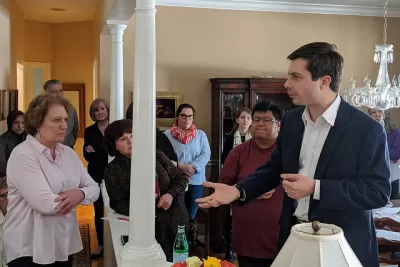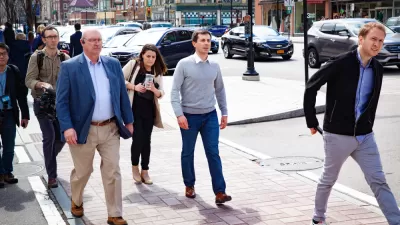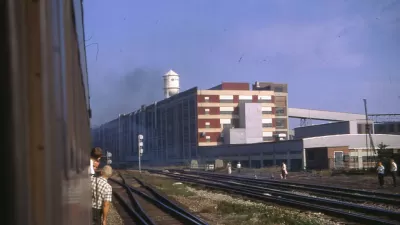Pete Buttigieg, in his eighth and final year as mayor of South Bend, Indiana, a formerly shrinking Rust Belt city, is on a roll in his bid to capture the Democratic nomination to challenge President Trump next year. The Indy Star looks at his record.

"Democrat Pete Buttigieg said Monday that his presidential exploratory committee raised over $7 million in the first quarter of 2019," reports Daniel Strauss for POLITICO. "The number is likely to put Buttigieg in the upper echelon of 2020 Democratic presidential hopefuls as they publicize their first-quarter fundraising numbers over the next two weeks."
When Mayor Pete Buttigieg (pronounced Boot-a-judge or Buddha-judge or Boot-edge-edge) of South Bend, Indiana, began his first term in 2012, he became the youngest mayor of a city over 100,000. Now in his final year as mayor of the state's fourth largest city, the 37-year-old candidate hopes to become America's youngest president. He launched his presidential exploratory committee on January 23.
"He’s the 'hottest candidate in the 2020 race,' according to CNN," writes Lisa Lerer in her "On Politics" column in The New York Times on March 28. "New Yorkers love him more than their own mayor. "
The year before Buttigieg took office, Newsweek listed South Bend as one of the top 10 dying cities in America, notes an August 2017 post by Planetizen managing editor James Brasuell about Buttigieg's efforts to transform what Mayor Pete calls "the beating heart of our entire region," the aging Studebaker factory that shut its doors in 1963, into a center of high-tech innovation. [Listen to the source article on Public Radio International.]
Unlike many, if not most medium-to-large coastal cities, Buttigieg doesn't measure progress by how many homes have been built – it's the opposite. Until 2014, South Bend, like many a Midwestern rust belt city, has been shrinking.
"Back in 2011, when Buttigieg was a 29-year-old knocking on doors to ask for votes, he heard the same question time and time again: What are you going to do about all of the vacant homes?" reports Chris Sikich for The Indianapolis Star in a deep-dive on the mayor's efforts to examine Buttigieg's claims that South Bend is now a "turnaround city."
Studebaker employed more than 24,000 workers at its height in the 1950s. As South Bend's population shrank by roughly a quarter over the five decades following its demise, large swaths of neighborhoods were left abandoned and crumbling.
Sikich describes Buttigieg's strategy to demolish or have homeowners repair dwellings. "Buttigieg decided to promote an aggressive timetable — 1,000 homes in 1,000 days [pdf]. The goal was surpassed, with 60 percent demolished and 40 percent repaired, and continues to this day.
Sikich continues his deep dive into the mayor's claims that South Bend is a "turnaround city." As with any city that is now experiencing investment, the fear of gentrification in the city "which is roughly 54 percent white, 26 percent black and 14 percent Hispanic" is real.
Complete streets initiative
"During his second term, he constructed safer, more appealing 'Smart Streets' as part of downtown placemaking," according to his city government mayoral webpage. A photo in Indy Star shows "bike-friendly paths and roads are the result of an infrastructure initiative by Mayor Pete Buttigieg in downtown South Bend."
In fact, "Smart Streets, which has eliminated one-way streets, narrowed them to slow traffic, widened and beautified sidewalks with new trees and decorative brickwork, and created new bike paths," was a factor in the downtown's revival, reported Jeff Parrott for the South Bend Tribune.
First mayor to be president?
Should Buttigieg win his party's nomination, not only would he be the first openly gay candidate of a major party for president, he would also be the first sitting mayor to receive the nomination, according to Nathaniel Rakich, FiveThirtyEight’s elections analyst. However, Anthony Williams, who served as the mayor of Washington, D.C. from 1999 until 2007, writes in CityLab that DeWitt Clinton was nominated in 1812 by the Fusion Party and lost to incumbent James Madison.
Sorry, this correspondent can't determine whether Clinton was mayor of New York City at the time or lieutenant governor of New York State. In any case, both writers agree that a sitting mayor has never been elected to president.
Additional reading:
- 'Turnaround city': Pete Buttigieg pushes theme of South Bend revival in run for president, South Bend Tribune, Jan 23, 2019
Related in Planetizen:
-
South Bend Has Big Innovation District Plans, August 30, 2017
-
South Bend Reactivating Vacant Lots, April 13, 2016
FULL STORY: Pete Buttigieg says he’s mayor of a turnaround city. Here’s how that claim stands up.

Maui's Vacation Rental Debate Turns Ugly
Verbal attacks, misinformation campaigns and fistfights plague a high-stakes debate to convert thousands of vacation rentals into long-term housing.

Planetizen Federal Action Tracker
A weekly monitor of how Trump’s orders and actions are impacting planners and planning in America.

San Francisco Suspends Traffic Calming Amidst Record Deaths
Citing “a challenging fiscal landscape,” the city will cease the program on the heels of 42 traffic deaths, including 24 pedestrians.

In U.S., Urban Gondolas Face Uphill Battle
Cities in Latin America and Europe have embraced aerial transitways — AKA gondolas — as sustainable, convenient urban transport, especially in tricky geographies. American cities have yet to catch up.

Detroit Says Problems With Property Tax Assessments are Fixed. Advocates Disagree.
With higher-valued properties under assessed and lower-valued properties over assessed, advocates say there's still a problem with Detroit's property tax system.

Defunct Pittsburgh Power Plant to Become Residential Tower
A decommissioned steam heat plant will be redeveloped into almost 100 affordable housing units.
Urban Design for Planners 1: Software Tools
This six-course series explores essential urban design concepts using open source software and equips planners with the tools they need to participate fully in the urban design process.
Planning for Universal Design
Learn the tools for implementing Universal Design in planning regulations.
Heyer Gruel & Associates PA
JM Goldson LLC
Custer County Colorado
City of Camden Redevelopment Agency
City of Astoria
Transportation Research & Education Center (TREC) at Portland State University
Jefferson Parish Government
Camden Redevelopment Agency
City of Claremont





























